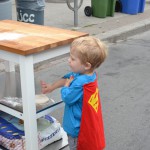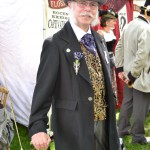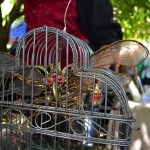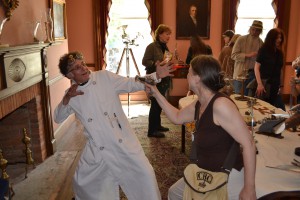Spring has given way to summer with a sudden shock of heat and numerous street festivals. While Toronto’s Pride Festival has grown over the years, this year we’re hosting World Pride (June 20-29) and expect to entertain over a million people! Some years, the popular Taste of the Danforth (August 8-10) has drawn over a million! Personally, I can’t handle crowds this big (unless I’m onstage!), so I get more enjoyment from smaller festivals. While festivals shut down roads, they make pedestrians (like me!) very happy. They offer an excuse to wander about, camera in hand, enjoying the day. During June, I’ve hung out at three such festivals.
The Annex Festival on Bloor was a neighbourhood street festival held between Spadina and Bathurst on the afternoon of Sunday, June 8. While there were food and craft vendors, demonstrations, music and kids’ events, it seemed a bit lack lustre. The late-afternoon rain probably didn’t help. No idea what attendance numbers were, but it’s a relatively small neighbourhood event.
The Taste of Little Italy was held the weekend of June 13-15 along College. I wandered its length from Bathurst to Shaw and back again early Saturday afternoon. It was notably busier on the way back, but I suspect it’s craziest in the evening. While I haven’t found attendance numbers, I suspect that over the three days attendance is in the hundreds of thousands, but it’s spread out both geographically and temporally, so it doesn’t feel particularly crowded. Similar to the Annex Festival, Taste of Little Italy has food and craft vendors, music, and stuff for kids; it’s simply more plentiful and splendid. Numerous restaurants along the strip extend into the street with portable kitchens, so cooking smells pervade the air. Bands play at four different venues throughout each day and evening, with music ranging from traditional Italian to rock; sometimes traditional dancers add to the festivities. At each end of the festival, away from the crowds, kids’ rides and amusement activities are set up. Because this year’s festival coincided with the FIFA World Cup, event organizers also constructed an enormous video wall inside a large licensed beer tent, so fans could come down and watch Italy play. Team jerseys were in evidence and clearly this year’s festival attracted lots of soccer fans. The highlight of my day was relocating Dolce Gelato so I could enjoy two scoops, one of cioccolato and one of pistachio Siciliano, a taste sensation I discovered with my Dad when I was seven and we were living in Rome.
Steam on Queen was the afternoon of June 21 at the historic Campbell House on Queen at University. As well as attracting vendors and entertainers, what I love about this festival is that it also encourages grown-up dress-up in vintage or steampunk fashion. While some of the vendors are local, many travel from out of province to sell their wares. Some sell vintage or handmade clothing, others sell jewellery or other trinkets handmade from repurposed watch parts and found objects. The entertainment is somewhat esoteric, including acrobatic rope work, belly dancing and a theremin player. Inside Campbell House, was a display of the inventions of R. Phinius Bodine (aka Russell Zeid, an educator from the Ontario Science Centre). Also on display inside Campbell House were some props and rushes from a remake of the 1927 Fritz Lang silent film Metropolis (at least that was my understanding… I might be wrong).
Not sure what mischief I’ll get up to in July, but I’m on the look-out!
© Catherine Jenkins 2014 all rights reserved







